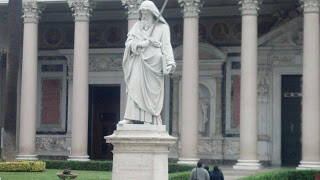Two of the tasks I have set for my blogging have been to present biblical studies in a format that is both accessible to a wide readership online and that steers clear of unnecessary controversy in order to present to this wide readership, which is theoretically an unlimited and ecumenical audience, information that allows readers to better engage and understand the Bible. Beginning in January 2012 and ending in March 2013, I blogged a commentary on the Gospel of Mark, available at the Bible Junkies blog and at America Magazine, which will be published in e-book and paperback sometime in January or early February 2014. I completed this task in March 2013. From March to May 2013, I blogged a commentary on the Letter of Jude and links to each entry are available here. From May to August 2013, I wrote a commentary on Paul’s First Letter to the Thessalonians. The fourth online Bible Junkies Commentary was a study of Paul’s second letter to the Thessalonians, which was written between September and November 2013.
The fifth Bible Junkies Commentary, which begins with this post, is a study of Paul’s powerful letter to the Galatians. This letter has been significant throughout Christian history, but it took on a pronounced and central role during the Protestant Reformation due to Martin Luther’s focus on “faith,” “works” and the central concept of “justification” in this letter. Indeed, I will engage with Luther’s own commentary on Galatians at times, not simply because I take positions contrary to his but because it is best to go the source and allow him to speak for himself. This does not mean, though, that my approach will be to pit “Catholic” and “Protestant” readings of Galatians against one another; rather my approach will be to rely on the best current scholarship on Galatians available and to situate Galatians in its early Christian and Jewish context to best understand the concrete situations among the Galatians, their relationship with Paul the Apostle, and the theological issues that resulted in this letter.
1. Introductory Matters:
I will repeat some of the background information with which I introduced the Thessalonian correspondence concerning ancient letters since some readers might be coming aboard with this commentary for the first time. In the past, biblical scholars often distinguished between an “epistle” and a “letter.” This distinction goes back to the work of Adolf Deissmann (see New Jerome Biblical Commentary, 769). A letter in this categorization is defined as a private, non-literary correspondence, while an epistle is a communication that is more literary in character, not necessarily occasioned by a particular event or situation and intended for a public audience. I will be using the terms interchangeably, since I consider that all of the letters in the New Testament, including the Pastoral epistles, were intended for public, not just private reading and that there is no definable difference between the literary character of “letters” and “epistles” in the New Testament.
Letters (or epistles) in the wider Greco-Roman world basically had four parts, though these can be sub-divided in numerous ways. The four basic parts are as follows:
1) Salutation (name(s) of writer(s) and recipient(s); greeting)
2) Thanksgiving
3) Body of the Letter
4) Closing: greeting.
Scholars of Paul often offer a number of other subdivisions and I will give a couple of examples to make this clear:
1) Salutation (name(s) of writer(s) and recipient(s); greeting)
2) Thanksgiving
3) Opening of the Body of the Letter
4) Body of the Letter (usually in two parts, theoretical and practical)
5) Closing of the Body of the Letter (often with the promise of a visit)
6) Ethical Instructions (‘Paraenesis’)
7) Closing: greetings; doxology; benediction (John Ziesler, Pauline Christianity, 7)
And:
1) Salutation: a) sender; b) recipient; c) greeting
2) Thanksgiving: (Prayer)
3) Body of the Letter (Paraenesis: Ethical Instruction and Exhortation)
4) Closing commands
5) Conclusion: a) peace wish; b) greetings; c) kiss; d) close (grace; benediction) (Calvin Roetzel, The Letters of Paul: Conversations in Context, 53-54)
For the letters of Paul, I have created a hybrid scheme based on the work of these scholars and my own understanding of Paul’s letters:
1) Salutation: a) sender; b) recipient; c) grace;
2) Thanksgiving: This often contains intentions for the entire letter and a prayer for the recipients;
3) BodyoftheLetter: often contains two parts, though not necessarily neatly divided: a) theological teaching and instruction, especially regarding errors in belief and practice; b) Paraenesis: Ethical Instruction and Exhortation;
4) ClosingoftheBodyoftheLetter: Closing commands, often with the promise of a visit and greetings;
5) Closing: Conclusion might contain some or all of these elements: a) peace wish; b) greetings; c) kiss; d) close (grace; doxology; benediction) (Roetzel, 53-54;Ziesler, 7)
2. The Background to Paul’s Activity in Galatia
A) The History of the Mission to Galatia: The letter is directed “to the churches of the Galatians” (tais ekklêsiais tês galatias). A number of churches are mentioned, but the big question regarding the recipients is whether the letter is directed to the Roman province in central Asia Minor, whose mission is described especially in Acts 13:14-14:23, or to the actual Celtic tribes, that is, Gauls who emigrated to Asia Minor in the 3rdcentury B.C.E. and who gave their name to this region. The Roman province theory is known as the South Galatia hypothesis, while the tribal theory is called the North Galatia hypothesis.
Proponents of the S. Galatia theory hold that the letter is directed to churches found in the Roman province and mentioned in Acts 13:14-14:23, such as Antioch in Pisidia, Lystra and Derbe. These scholars equate the journey to Jerusalem described by Paul in Galatians 2:1-10 with that mentioned, briefly, in Acts 11:29-30. This would explain the absence of the “apostolic decrees” in the letter to the Galatians, those decrees formulated by the Jerusalem council concerning fornication, meat offered to idols, etc. and mentioned in Acts 15:20 and 29, since the assumption would be that Galatians was written before the Jerusalem council took place. Since the council took place around 50 C.E., the letter to the Galatians would have an early date in the late 40's. This would make this letter about as early as the first letter to the Thessalonians.
Those who follow the N. Galatia hypothesis sees the recipients as the actual Galatian tribes, the churches of the descendants of the Gauls or those churches in the actual Galatian tribal territory. The journey to Jerusalem which Paul describes in Gal. 2:1-10 is correlated with the journey of Paul and Barnabas outlined in Acts 15. Exponents of this view tend to date the letter to a later time frame, such as 55 C.E. or even to 57 C.E. I follow the N. Galatia hypothesis and do think that the letter is written to “Galatians.” Paul speaks of them as “foolish Galatians” (3:1), a linguistic usage which indicates a “people” distinct from other peoples, though this need not imply that everyone who belonged to the Galatian churches was an actual Gaul. The problem for this hypothesis is why Paul does not mention the “apostolic decrees” of Acts 15 in Gal. 2:1-10 and in fact says in Gal. 2:10, “they asked only one thing, that we remember the poor, which was actually what I was eager to do.” A supporter of the N. Galatia hypothesis will have to answer why Paul ignores these decrees in a letter written some years after he attended the council of Jerusalem.[1]
B) The Founding of the Church:Both Galatians 1:6-9 and 3:1-5 indicate that the Church in Galatia was founded by Paul. In Galatians 1:8, for instance, Paul says, “even if we or an angel from heaven should proclaim to you a gospel contrary to what we proclaimed to you,” which points to his initial preaching with his co-workers (though none are listed as co-authors in Galatians; in Galatians 1:2 he makes mention only of “all the brothers who are with me”). This is supported by Galatians 3:2, where Paul writes, “the only thing I want to learn from you is this: Did you receive the Spirit by doing the works of the law or by believing what you heard?” It points back to experiences which took place when Paul was among them at the first and why he is so upset that they appear to be abandoning the Gospel.
C) The Situation in Galatia: Paul is passionately and sometimesangrily defending his ministry and Gospel to the Galatians in this letter. There are clearly “opponents” whom Paul is addressing, people who have come from the “outside” (Galatians 17, 5:10, 12). These people have come to the Galatian churches arguing for observance of Judaic practices, that is, the Law of Moses, as necessary for salvation; the shorthand for this in Paul’s letter is “circumcision.” Who are these “opponents”?
Without question these opponents were, like Paul himself, Jewish Christians, but these Jewish Christians believed that it was essential that all Christians, Jewish or Gentile, continue to follow the Law of Moses. They did not believe that the coming of the Messiah indicated that the Law of Moses was no longer valid; they either did not know of the Jerusalem council (or, some might argue, the council had not yet taken place) or they ignored its decrees, which is more likely, since the decrees of the Jerusalem council did have strong opposition as seen in Acts 15:1, 5.
The opponents in Galatians are probably those Christians we see in Acts 15 opposed to the council’s decisions, or aligned with them, and who rejected a mission to the Gentiles without the Torah. They also attempt to discredit Paul himself as an apostle, which is why Paul finds it essential to defend not just his Gospel but himself (Galatians 1:1, 11-12). Paul denies in Galatians that by arguing for the sufficiency of Christ he is at odds with the promises of God to the Jewish people.
D) Authorship: There has been no significant questioning of Paul’s authorship of this letter either in antiquity or by modern scholars. Indeed, with Romans, Galatians has been seen as the example par excellence of Pauline epistles.
E) Place: If one supports the S. Galatia hypothesis and so an earlier date for the letter, the probable place of writing would be Corinth. If one follows the N. Galatia hypothesis and so a later date for the letter, the most likely place would be Ephesus or Corinth.
Next entry, we begin to look at the content of the letter.
John W. Martens
I invite you to follow me on Twitter @Biblejunkies
I encourage you to “Like” Biblejunkies on Facebook.
This entry is cross-posted at Biblejunkies
[1]The N. Galatia hypothesis, which I support, is the most dominant view among scholars today, but see Michael Gorman, Apostle of the Crucified Lord, 184-86, for a defense of the S. Galatia hypothesis.








